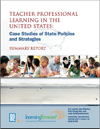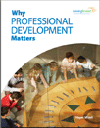Research and Reports
In an effort to understand and document the elements that make professional learning communities effective, a new report presents case studies of two schools drawn from survey data of 33 New Jersey public schools involved in a state-sponsored professional learning community training program. The report, Building a Learning Community: A Tale of Two Schools, is authored by Dan Mindich and Ann Lieberman and produced through Learning Forward and the Stanford Center for Opportunity Policy in Education (SCOPE). Among the key findings: sustaining focus is vital, collegiality is not enough, and leadership is key. This is the final report from the multiphase research initiative, Status of Professional Learning.
Read MorePolicy shapes practices, and the increasingly important realm of professional development is no exception. To identify effective professional development policies and strategies, the Stanford University research team examined the policy frameworks supporting high levels of professional development activity in four states in Phase III of the multiyear research study.
The states—Colorado, Missouri, New Jersey, and Vermont—were identified as “professionally active” based on evidence of high levels of teacher participation in professional development in the 2008 Schools and Staffing Survey (SASS), administered by the National Center for Education Statistics, and the teacher surveys associated with the 2009 National Assessment of Educational Progress (NAEP); a reputation in the literature for enacting reforms that are consistent with the research based on “effective” professional development; and improvements in student achievement as measured in the 2009 NAEP.
Read MoreThe report from Phase II of this multiyear research initiative examines the status of professional learning in the United States. The findings indicate that the nation is making some progress in providing increased support and mentoring for new teachers. However, the study also reveals that teachers’ opportunities for the kind of ongoing, intensive professional learning that research shows has a substantial impact on student learning are decreasing.
Researchers examined 2008 data from the federal government’s Schools and Staffing Survey (SASS) and other sources. The report also includes assessments of each state on the quality of their professional development across 11 indicators that comprise a newly developed Professional Development Access Index.
Read MoreIn 2009, NSDC released Professional Learning in the Learning Profession: A Status Report on Teacher Development in the United States and Abroad. This report examines what research has revealed about professional learning that improves teachers’ practice and student learning. The report describes the availability of such opportunities in the United States and high-achieving nations around the world, which have been making substantial and sustained investments in professional learning for teachers over the last two decades. Funding for the multiyear research effort comes from the Bill and Melinda Gates Foundation, MetLife Foundation, NSDC, and The Wallace Foundation.
Read MoreLaunched in 2008 by NSDC and a team of researchers from the Stanford Center for Opportunity Policy in Education (SCOPE), the three-part Status of Professional Learning research study aims to measure the effectiveness of professional learning in the United States. Funding for the multiyear research effort comes from the Bill & Melinda Gates Foundation.
Read MoreWritten for parents, community members, and policy makers by Learning Forward’s senior distinguished fellow, this booklet explains in fundamental terms what professional development is and why it is an important school improvement strategy.
This series of Q-and-As is useful for helping audiences outside of education to understand this critical topic. Download the publication to share at board meetings or community gatherings. Share copies with local, state, and federal policy makers in your advocacy work.
Read More


